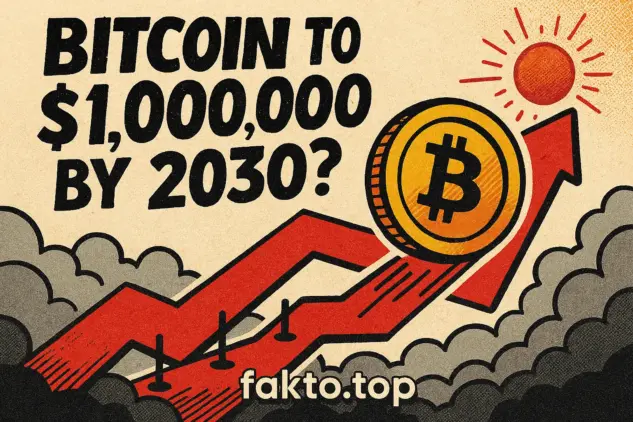Bitcoin to $1,000,000 by 2030? The Shocking Case for the Ultimate Financial Revolution
Bitcoin at $1,000,000 by 2030: A Deep Dive into the Digital Gold Thesis
The idea of Bitcoin reaching $1,000,000 per coin by 2030 sounds like either the ultimate financial revolution or the final boss of speculative hype. Yet when the noise fades and we zoom into fundamentals, macro shifts, and capital flows, the million-dollar scenario becomes less fantasy and more of a bold, high-conviction analytical model. Not guaranteed — but not impossible either.

This is the “Digital Gold” thesis in its most aggressive form: Bitcoin absorbs meaningful portions of multi-trillion-dollar global asset classes. The world doesn’t need to fully reinvent itself — it just needs to keep moving in the direction it’s already going. A slow but steady shift away from centralized trust and inflation-prone systems toward algorithmic scarcity and decentralized verification.
The People Behind the Million-Dollar Prediction
Importantly, this forecast isn’t coming from anonymous Twitter avatars with laser eyes. It’s supported by some of the most influential investors and executives steering institutional capital. When capital allocators with billions under management start treating Bitcoin not as a meme, but as a strategic asset, the paradigm begins to tilt.
Cathie Wood and ARK Invest
ARK Invest has publicly presented a bull-case scenario where Bitcoin reaches $1.5M by 2030. Their reasoning rests on:
- Institutional Adoption: With Spot ETFs now in motion, traditional finance has a regulated path to Bitcoin exposure. The floodgates are open — pension funds, sovereign wealth funds, and endowments can now access Bitcoin through familiar financial instruments.
- Reallocation from Gold: Bitcoin is positioned as the superior store of value due to portability, verifiability, and its immunity to physical confiscation. In a digital world, gold’s physical nature becomes a disadvantage.
- Wallet Growth: The network effect accelerates as more people self-custody or interact with BTC-backed platforms. Each new participant doesn’t just add value — they multiply it.Jack Dorsey and Michael Saylor
These aren’t just investors — they are Bitcoin maximalists on a philosophical mission. The message is simple: Fiat dies, scarcity wins. Saylor calls Bitcoin the “apex digital property” — everything else is just waiting to sell to it. Dorsey views it as a tool of global financial freedom, particularly for developing nations where inflation destroys savings faster than wages can rise.Larry Fink and the TradFi Pivot
When the CEO of BlackRock calls Bitcoin a “flight to quality” asset and an “international store of value,” that’s not a meme. It signals the unlocking of passive, index-level global capital — the kind that moves mountains. BlackRock doesn’t follow trends; it builds them. Their involvement signals that Bitcoin is no longer on the fringe — it’s entering the core of portfolio theory.
The Math Behind the $1,000,000 Price Target
To hit $1M per BTC, the market cap must rise to around $20 trillion. That doesn’t happen by crypto trading itself — it requires reallocations from major asset classes, as Bitcoin becomes a recognized global store of value.
| Target Market | Current Market Size | Required BTC Capture |
|---|---|---|
| Gold (Store of Value) | $15 Trillion | ~50% |
| Global Monetary Base | $25 Trillion | ~10% |
| Offshore Wealth / Hedge Capital | $10 Trillion | ~15% |
| Global Real Estate (Fractional Store Value Component) | $360 Trillion | <1% |

Each small reallocation represents massive nominal inflows. If just 1% of global wealth preservation capital treats Bitcoin as a hedge against fiat devaluation, the price could exceed $500,000. A modest shift in perception — not a revolution — is enough to rewrite financial history.
Key Drivers That Could Send Bitcoin to $1,000,000
1. The Halving Supply Shock
Bitcoin’s issuance decreases predictably. Every four years, the reward given to miners halves. Unlike gold mining, where higher prices incentivize more production, Bitcoin supply cannot rise to meet demand. This structural constraint pushes long-term price upward as scarcity compounds with time. In 2028, the block reward will drop to just 1.5625 BTC — a minuscule trickle compared to growing demand from ETFs and sovereign entities.
2. Global Monetary Instability
Debt expansion, inflation, and distrust in sovereign currency create a systemic hunger for non-political, digitally scarce value storage. When countries debase their currency to finance deficits, Bitcoin stands as an opt-out mechanism. It’s not anti-government — it’s anti-fragility. As geopolitical and fiscal stress intensify, Bitcoin becomes the “Plan B” for both individuals and institutions.
3. The Hyperbitcoinization Network Effect
Adoption scales non-linearly. Every new participant increases utility for all existing participants. This is where the price charts stop being curves and start being cliffs. As payment rails, remittance systems, and digital savings apps integrate BTC, people start holding it not because it’s trendy — but because it works. The network reinforces itself through liquidity, interoperability, and trustless settlement.
4. The Institutional On-Ramp
Spot ETFs are just the beginning. Custody infrastructure, accounting standards, and risk models are aligning for the first time. When compliance frameworks stabilize, we’ll see a wave of corporate balance-sheet allocations. The same way Tesla or MicroStrategy made headlines in the 2020s, entire sectors — from insurance to energy — could follow suit by the late 2020s.
5. Cultural Legitimization
Bitcoin’s story is evolving from “speculative asset” to “monetary revolution.” As younger generations — digital natives — inherit and manage more wealth, they tend to trust decentralized code more than centralized promises. This demographic shift will act as a quiet but unstoppable driver of demand.
Reality Check: Risks on the Path to $1,000,000
Regulation
Coordinated G7/G20 restrictions could slow institutional adoption dramatically. However, history shows that Bitcoin tends to adapt faster than regulators. Bans redirect liquidity; they don’t destroy it. The rise of decentralized exchanges and self-custody wallets ensures survivability, even under hostile policy environments.
Scalability and Security
Layer-2 systems like Lightning and emerging technologies such as Fedimint or Ark must scale sustainably without compromising decentralization. The challenge isn’t technical — it’s social: building tools that millions can use safely without trusting intermediaries. Success here would cement Bitcoin’s role as the global settlement layer of the digital age.
Competition from CBDCs
State-backed digital currencies may attempt to crowd out Bitcoin’s transactional use-cases. Yet, CBDCs are the opposite of Bitcoin in design — centralized, permissioned, and surveilled. Bitcoin offers something no government coin ever can: neutrality. Rather than competing, these systems will coexist, serving entirely different philosophical and functional purposes.
Volatility and Investor Psychology
Drawdowns of -50% remain part of the Bitcoin experience. Conviction is required. Yet volatility isn’t a flaw — it’s a reflection of a free, uncensored market discovering fair value. As the market matures and liquidity deepens, volatility should gradually compress, turning Bitcoin from a rollercoaster into a blue-chip asset.
Technological Stagnation
While Bitcoin’s simplicity is its strength, innovation around it must continue — especially in privacy, UX, and financial integration. If the ecosystem stagnates, altcoins or sidechains could siphon off use-cases. Fortunately, open-source development remains vibrant and globally distributed.

Beyond the Numbers: The Philosophy of Bitcoin as “Digital Gold”
To understand the million-dollar thesis, one must see Bitcoin not only as code but as an idea. It represents the separation of money and state — a technological expression of individual sovereignty. In a world increasingly ruled by algorithmic control, Bitcoin restores choice. That idea, once seeded, is hard to reverse.
Every generation redefines value. The 20th century trusted central banks and governments. The 21st is learning to trust cryptographic truth. Bitcoin at $1,000,000 isn’t merely a price prediction — it’s a signal that the world has recalibrated its definition of safe haven.
Conclusion
Is $1,000,000 Bitcoin guaranteed? No. Is it structurally plausible under current macro trends? Absolutely.
A realistic base-case by 2030 is $600,000 to $750,000. The $1,000,000 target is the bull peak scenario where everything aligns: adoption, macro pressure, regulatory neutrality, and accelerating network effects. But even if it falls short, the societal shift it represents — the migration from trust to verification — is irreversible.
The million-dollar Bitcoin story is not hype versus reality — it is reality scaled to its logical extreme. Bitcoin doesn’t need the world to believe in it all at once; it just needs to keep proving itself one block at a time.
Key Questions and Answers
1. Does Bitcoin need to replace the U.S. Dollar to reach $1,000,000?
No. It only needs to be widely recognized as a long-term store of value and absorb a portion of global capital markets. Bitcoin can thrive alongside fiat currencies, functioning as a parallel monetary system.
2. Can governments realistically ban Bitcoin?
They can regulate access points, but a decentralized network with global node distribution is extremely difficult to eliminate. Like the Internet, Bitcoin routes around censorship. It is a network, not a company — and networks are resilient.
3. Will CBDCs destroy Bitcoin’s use case?
No. CBDCs are centralized. Bitcoin’s core value is decentralization. They occupy fundamentally different roles — one as a state tool, the other as a tool of individual freedom.
4. Is Bitcoin too volatile to serve as a store of value?
Volatility is the cost of early adoption. As market cap grows, volatility naturally decreases. Those who endure the chaos of early cycles are often rewarded for their patience.
5. Do we need new technology upgrades for Bitcoin to scale to global use?
Layer-2 networks like Lightning are already making large-scale transactions possible without changing Bitcoin’s base layer. This modular approach preserves security while enhancing speed and usability — a crucial design decision that ensures longevity.
Whether it’s $500,000, $1,000,000, or beyond — the real story is not the number, but the shift in global consciousness that Bitcoin represents. The transition from trust in institutions to trust in mathematics is already underway. By 2030, we’ll know just how far that trust can take us.

